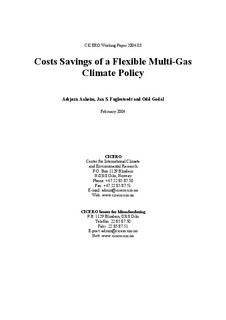| dc.contributor.author | Aaheim, H. Asbjørn | nb_NO |
| dc.contributor.author | Fuglestvedt, Jan S. | nb_NO |
| dc.contributor.author | Godal, Odd | nb_NO |
| dc.date.accessioned | 2014-03-17T14:31:23Z | |
| dc.date.available | 2014-03-17T14:31:23Z | |
| dc.date.issued | 2004 | nb_NO |
| dc.identifier.issn | 0504-452X | nb_NO |
| dc.identifier.uri | http://hdl.handle.net/11250/192324 | |
| dc.description.abstract | Current climate policies are based on the use of the Global Warming Potential (GWP) index to compare various greenhouse gases. Yet, from an economic point of view, more efficient methods exist. The purpose of this paper is to examine the potential cost savings from applying an efficient and more flexible metric as compared to using GWPs, given some long-term goal for stabilization of the climate. We also calculate the costs when only emissions of carbon dioxide (CO2) are targeted. As compared to the least cost multi-gas flexible case, we estimate that the mitigation costs are increased by about 2% by using GWPs, which amounts to about 16-106 Billion US $ per year depending on the stabilization goal. If only CO2 emissions are targeted, costs increase by about 11%. Given our assumptions we conclude from this that most cost savings that stem from including non-CO2 greenhouse gases in climate policy may be realized when applying GWPs, even though these gas tradeoffs are rather different from the efficient ones. | nb_NO |
| dc.language.iso | eng | nb_NO |
| dc.publisher | CICERO Center for International Climate and Environmental Research - Oslo | nb_NO |
| dc.relation.ispartof | CICERO Working Paper | nb_NO |
| dc.relation.ispartofseries | CICERO Working Paper;2004:03 | nb_NO |
| dc.title | Costs Savings of a Flexible Multi-Gas Climate Policy | nb_NO |
| dc.type | Working paper | nb_NO |
| dc.source.pagenumber | 21 | nb_NO |
| dc.identifier.cristin | 400444 | |
